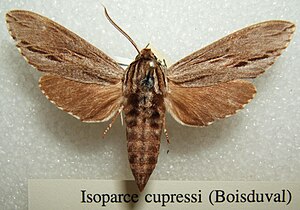Isoparce cupressi
| Isoparce cupressi | ||||||||||||
|---|---|---|---|---|---|---|---|---|---|---|---|---|

Preparation from Isoparce cupressi |
||||||||||||
| Systematics | ||||||||||||
|
||||||||||||
| Scientific name | ||||||||||||
| Isoparce cupressi | ||||||||||||
| ( Boisduval , 1875) |

Isoparce cupressi is a butterfly ( moth ) from the family of moth (Sphingidae).
features
The moths have a fore wing length of 28 to 37 millimeters. They can be easily distinguished from other hawk species by the pattern of the forewings and the monochrome brown hind wings. The outer edge of both pairs of wings is colored alternately white and brown. Slight sexual dichroism occurs in the species . The females are very faintly patterned and have only a subapical and medial black stripe. In the males, the medial area of the forewings is provided with a dark brown band that includes fine black and white stripes. The black band fades on older copies.
The caterpillars are very impressively colored, but they are perfectly camouflaged on the food plants. There are three color options. The green one has a broad dark brown colored back, which the brown and pink forms lack. The caterpillars are strongly spotted with white. There is a pair of subdorsal and subspiracular bandages on each segment. The anal horn is quite fleshy and strongly curved backwards.
The elongated doll is dark brown and has a fairly smooth surface that is slightly shiny. The wide, teardrop-shaped cremaster is black and ends in a double point.
Occurrence
The species is tied to the swamps of the southeastern United States with occurrences of cypress trees , but their actual distribution has not been adequately researched due to the inaccessibility of these habitats. The species is distributed from the flat coastal regions of North and South Carolina, Georgia and Florida as well as further west over the southern areas of the states of the Gulf Coast to Bexar County in Texas. In the north, the distribution extends over the valley of the Mississippi River and several of its eastern tributaries, for example in southeast Missouri and southwest Kentucky. There is also evidence from Indiana. The species is also found in Mexico.
Isoparce cupressi inhabits swamps and slow-flowing rivers where bald cypress trees ( Taxodium distichum ) grow in abundance.
Way of life
The moths fly to light sources at night. It is not known whether they can ingest food, especially since they only have a very short proboscis .
Flight and caterpillar times
In South Carolina, the species flies in two generations from mid-March to mid-May and August to September. A similar phenology was found in Florida. The moths were observed in Indiana in mid-August. Since this is very late for an area so far to the north, it is unclear whether this is only a mistake. In Louisiana, the species flies in at least four generations from February to October.
Food of the caterpillars
The caterpillars feed on bald cypress ( Taxodium distichum ).
development
The females lay their eggs one by one at the end of branches on the underside of the needles of the food plants. The caterpillars live solitary and eat at night. Pupation takes place in tufts of moss that grow above the waterline on the trees between cracks in the bark. This ensures that the animals can survive despite the frequent flooding of their habitats.
supporting documents
Individual evidence
- ↑ a b c d e f g h i James P. Tuttle: The Hawkmoths of North America, A Natural History Study of the Sphingidae of the United States and Canada. The Wedge Entomological Research Foundation, Washington, DC 2007, ISBN 978-0-9796633-0-7 .
- ↑ a b c Sphingidae of the Americas. Bill Oehlke, accessed December 28, 2011 .
literature
- James P. Tuttle: The Hawkmoths of North America, A Natural History Study of the Sphingidae of the United States and Canada. The Wedge Entomological Research Foundation, Washington, DC 2007, ISBN 978-0-9796633-0-7 .